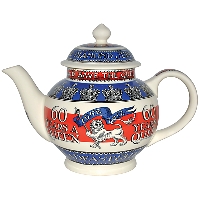Collecting Novelty Teapots jubilee Teapot History
Launch gallery slideshow

| Group: | cuppa and letter group |
| Swap Coordinator: | reauk (contact) |
| Swap categories: | |
| Number of people in swap: | 3 |
| Location: | International |
| Type: | Type 1: Electronic |
| Rating requirement: | 4.90 (unrated swappers allowed) |
| Last day to signup/drop: | June 4, 2012 |
| Date items must be sent by: | June 10, 2012 |
| Number of swap partners: | 20 |
| Description: | |
|
Collecting Novelty Teapots Teapot History There is nothing more reassuring than a good old cup of tea" - it's part of the British heritage and a way of life. The vessels that brew the tea have been cast and made into every conceivable shape known to man, they possess that unique sense of welcoming appeal that only teapots can give. In the modern day collecting world the novelty teapot reigns supreme. Tea first came to Britain in the middle of the 17th Century and with it came the teapot. Tea drinking had originated in China, the home of the tea plant, and was almost certainly brewed some 2,000 years ago. The teapot probably derived from ceramic kettles and wine pots with shaped spouts and the tea was drunk from tiny bowls. The first tea advertisements were dated from around 2nd-9th September 1658 and were reported alongside the death of Oliver Cromwell with the words "That excellent, and by all Physitions approved, China Drink, called by the Chineans 'Tcha', by other nations 'Tay', alias 'Tee', is sold at the Sultaness-head, a Cophee-house, in Sweetings Rents by the Royal Exchange, London". China was significantly more advanced than the rest of the world in porcelain manufacture and by the mid-17th Century had begun to export its tea and tea vessels to other countries around the globe. China's ability to supply tea and the craze in the West for drinking it, was such that it soon became a major cargo and from the 1720s tea filled some 90% of the space in ships' holds. The ships that brought the tea also carried porcelain teapots, tea bowls and saucers and were deemed to be essential to the enjoyment of tea drinking. The earliest of these teapots were made from red stoneware and were known as Mixing: they are still made today and can be found on the auction sites such as eBay. Potteries soon sprang up in England and began to manufacture these pots in their own styles, amongst the earliest being Wedgwood and Whieldon. These were the earliest forms of the novelty type teapots and were cast into shapes of pineapples, cauliflowers and various exotic fruits; later styles changing to the shape of two-storey houses, cockerels send 5 photos of your favourite tea pots.if you dont collect tea pots still like to join the swap thats fine. | |
Discussion
Leave a Comment
You must be logged in to leave a comment. Click here to log in.
- Info:
- Home
- |
- About
- |
- Forum Rules
- |
- Terms of Use
- |
- Press
- |
- Advertising
- |
- Blog
- |
- Graphics & Stuff
- Help:
- New User Info
- |
- FAQ
- |
- Group Info
- |
- Glossary
- |
- Forums
- |
- |
- Contact Admin

